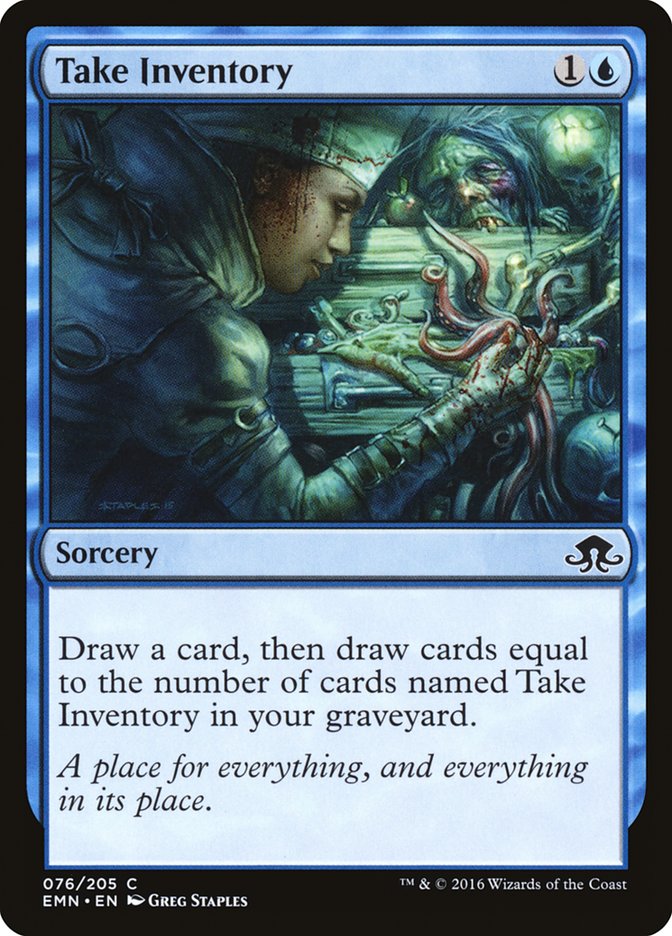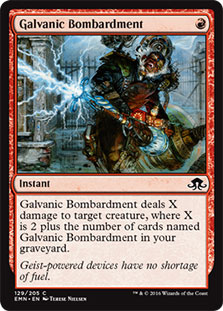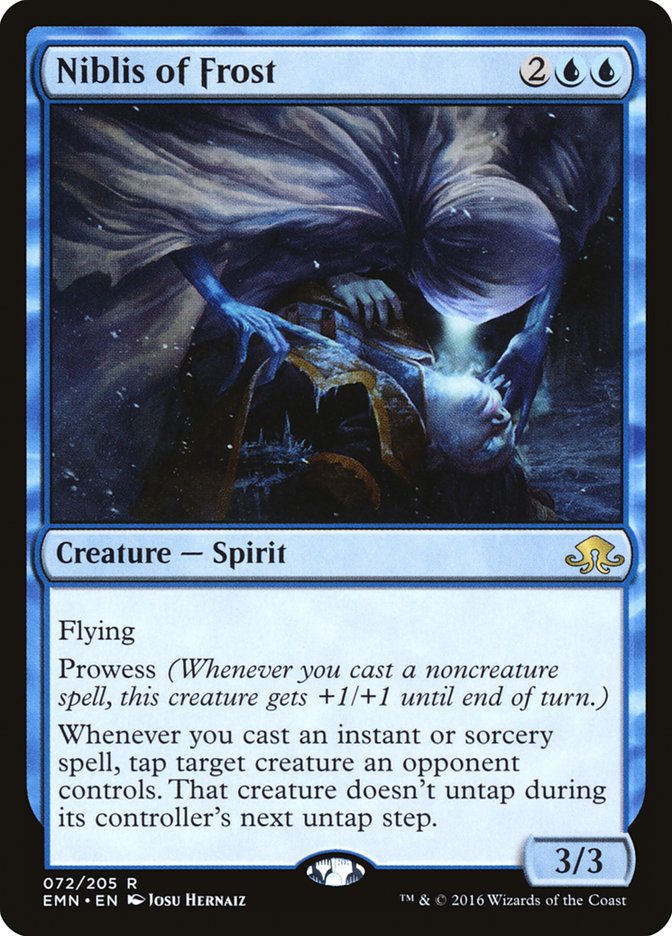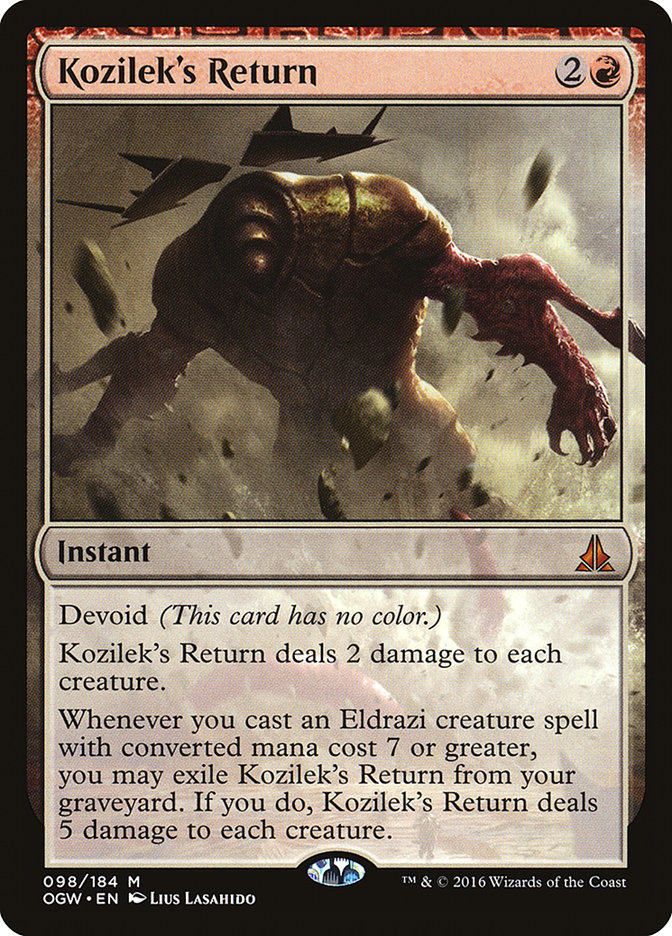Have you noticed how every single Izzet mechanic is something about spells mattering? Prowess is now evergreen but is primarily found on Izzet cards after starting life as a Jeskai mechanic in Khans of Tarkir. Blue has looting, while red has rummaging. Rebound may have spilled over into white but it was primarily blue. Then we have spell mastery and surge. Madness spills onto Vampires because they share a color with Izzet, but outside of that one tribe it’s a spell-focused mechanic.
Even the gold cards continue the theme with recent printings Stormchaser Mage; Jori En, Ruin Diver; and Fevered Visions. It’s pretty clear by this point what Izzet wants to do. Spells, spells, and more spells. Step one, cast spells. Step two, profit. It’s a guild that knows what wants to do and does it well. With Wizards R&D pumping so many spells-matter mechanics into recent sets, it may be time to let the creatures take a backseat for a change and let us get back to slinging some honest-to-goodness spells.
A quick Gatherer search yields the following cards that already exist in Standard for us to build with:
And Eldritch Moon, despite being less than halfway revealed, has some exciting new options that can fill out some decks that are just short on quality pieces.
Both of these cards offer a mediocre front end with the promise of better value later on as you draw more copies. That means you are incentivized to play the full playset as well as play them in a deck that wants to play longer games, so you give yourself more time to draw the second, third, and fourth. Fortunately, Take Inventory fits nicely into a long game as a card draw spell and pairs nicely with the cheap removal spell that can give you time in the early-game but will not become dead as the game goes long.
The second copy of Bombardment kills many creatures in Standard like Sylvan Advocate and Reflector Mage, while the third copy can take down an Archangel Avacyn. That kind of scaling lets you play a deck with a low enough curve to handle aggressive decks without falling to more powerful threats, a balance that is typically tricky to walk for reactive decks.
Still, the first instance of these cards will always be mediocre, as a cycle and Shock respectively, and it is this effect that you will get the most often. The way Standard plays right now, you may not have time to cast the first copy of Take Inventory without falling quite far behind. Players got around this issue with Take Inventory’s predecessor, Accumulated Knowledge, by pairing it with Intuition. Intuition allowed you to search for three copies of Accumulated Knowledge at instant speed, putting one into your hand and the other two in your graveyard, giving you immediate access to a two-mana Ancestral Recall.
The beauty of the pairing was that it was not uncommon to draw the first Accumulated Knowledge, which you could hold until after the Intuition, leaving you with the two best copies of the card. We don’t have a pairing as powerful these days, but there are still ways to get the mediocre copies of these cards into your graveyard so you only cast the great ones.
The most obvious way to do so is to discard them directly. Jace, Vryn’s Prodigy and Pore Over the Pages let you filter away the early copies while simultaneously digging for more. And once you’ve drawn three or four cards, you can use Jace, Telepath Unbound to recast it. Jace hasn’t seen as much play since the rotation of fetchlands, but with enough cheap removal like Galvanic Bombardment in the format, you can fill your graveyard and transform it more reliably.
You can also put these cards directly into your graveyard from your library with the various self-mill cards in the set. We have yet to see great options for the kind of deck I am looking to build, but Gisa and Geralf could combine with Take Inventory to create a powerful attrition-based Zombie deck if given enough pieces.
For now I’m taking a wait and see approach with Eldritch Moon on this angle, since sacrificing an entire card just to hope to mill a Take Inventory or two isn’t a good plan. You need the self-mill effect to be seamlessly attached to a card you want to play anyway, such as Pieces of the Puzzle.
I’ve been somewhat surprised by the lack of discussion over this card, especially with the obvious historical comparison to Looter il-Kor. In this case the predecessor saw limited play, mostly relegated to Time Spiral Block Constructed, but it certainly wasn’t surrounded by the tools that Wharf Infiltrator is.
Infiltrator also gives you much flexibility in that you can choose which card you discard to its ability without worrying about sacrificing value. Your spells will nearly all have madness or function from the graveyard, like Take Inventory, while all your creatures can be immediately converted into 3/2 tokens. Either way you are generating value, but now you get to choose between developing your own battlefield or reacting to your opponent’s, whichever you may need at the time.
For the sorts of Izzet decks I am looking into, having that flexibility is very important since they need to find a delicate balance between action and reaction, between aggro and control. You need to be able to do both at the same time in many spots, as well as switch seamlessly between them as the game state dictates. These decks rely on flexibility so their opponents are always off-balance and often play into your hand while overvaluing the threat of another card.
Having looked at what the new options are, let’s see how the various parts can come together to form a working machine:
Spells (28)
- 4 Anticipate
- 4 Hydrolash
- 4 Epiphany at the Drownyard
- 4 Engulf the Shore
- 4 Pieces of the Puzzle
- 3 Rise from the Tides
- 1 Nagging Thoughts
- 4 Take Inventory
Sideboard

This deck is clearly derivative of Martin Muller’s Mono–Blue Prison deck, but with the power of Take Inventory I think the deck can take on a more traditional control plan, using Engulf the Shore and Thing in the Ice to play early defense for long enough to set up an unbeatable Docent of Perfection or Rise from the Tides. Without the ability to close games quickly, the original list was dependent on finding an early Prism Ring to give it the necessary time to execute its gameplan. It was also reliant on Jace’s Sanctum to set up key plays like Part the Waterveil plus Day’s Undoing or Engulf the Shore plus Day’s Undoing.
With this list, you’re just looking to have an early sweeper in Thing in the Ice or Engulf the Shore, clear your opponent’s battlefield on turn 4 or 5, and then turn the corner with a 7/8 Horror, a big Rise from the Tides, or Docent of Perfection.
Docent curves particularly well with Engulf the Shore, letting you land it on a stable battlefield and leaving your opponent with the unenviable choice between re-deploying their creatures or answering yours. Docent can end the game incredibly quickly in this deck, flipping after your third spell and giving you an attack force with fifteen power in the air.
Rise from the Tides threatens to create a similarly lopsided battlefield, especially when fueled by Pieces of the Puzzle and Epiphany at the Drownyard. The threat of Rise can allow you to play some mind games with your opponent, making some unorthodox splits that will either stock your hand with plenty of action or stock your graveyard with plenty of potential Zombies.
Niblis of Frost replaces similar creatures that appeared in this deck’s sideboard, like Guardian of Tazeem and Dragonlord Silumgar, letting you have a similarly dominating threat in the air but at a significantly lower cost. This deck can easily cast two spells a turn, making Niblis a 5/5 flier with a recurring Frost Breath stapled on it. Few midrange decks are going to be able to keep up with such a threat, and any removal spells they keep in simply give you more time to dig through your deck and find Engulf the Shore and Rise from the Tides.
If you’re looking to use madness to enable Take Inventory, the deck shifts to a more traditional U/R Control shell:
Creatures (11)
Planeswalkers (2)
Lands (25)
Spells (22)
- 4 Fiery Temper
- 3 Lightning Axe
- 4 Tormenting Voice
- 2 Pore Over the Pages
- 1 Avacyn's Judgment
- 4 Galvanic Bombardment
- 4 Take Inventory
Sideboard

Creatures, card draw, and removal spells. It doesn’t get much cleaner than that. Kill their stuff. Draw some cards. Get around to killing them at your leisure. Niblis of Frost does great work here, letting you deal with larger creatures that the red removal spells often miss. It also lets you take the time to tap out for a bunch of card draw spells without falling behind to your opponent’s creatures. You can even tap down a Gideon, Ally of Zendikar with any instant, so untapping with this one on the battlefield should run away with the game very quickly.
Still, Gideon and other planeswalkers can definitely be an issue, even with your creatures all being effective at pressuring planeswalkers. None of your burn spells suffice as a one-for-one answer for most planeswalkers, and your more reactive hands will likely fall to an aggressive draw backed up by a planeswalker or two. As such, I could easily see a Negate or other counterspell serve a nice role as a two-of in the maindeck, since as is this deck is likely overprepared for creatures and can afford to devote resources elsewhere.
The good news is you generate so much card advantage that you can keep up with the value they give going long, even if you have to two-for-one yourself to answer a key threat. As the game goes long, you get to cast and re-cast Ancestral Recall, so don’t be afraid to give up value just to keep the battlefield stable and make sure the game goes long.
This list is rough, and I’m sure adjustments will be made to the balance between discard outlets and Madness cards. Right now I’d say that this list has a few too many outlets for the amount of madness in the deck, but with Drownyard Temple and the graveyard-counting cards, there is still plenty of synergy there to provide value.
I also like Drownyard Temple for its ability to enable Eldrazi Obligator out of the sideboard. Ramp decks of all forms should be bad matchups in Game 1 and you need to shift into an aggressive gameplan and be able to finish them off with a big attack after they tap out for one of their heavy-hitters.
And finally, if you like spells but still want to be plenty aggressive, you can go this route:
Creatures (20)
- 4 Jace, Vryn's Prodigy
- 4 Goblin Dark-Dwellers
- 4 Insolent Neonate
- 4 Wharf Infiltrator
- 4 Stromkirk Occultist
Planeswalkers (1)
Lands (25)
Spells (14)
Sideboard

This is another deck where striking the right balance between spells and creatures, between enablers and payoffs, will be important. The amount of filtering in the deck helps mitigate this to some extent and you really do want to have one of your looting cards in the early turns. Once your engine is online, it can feel like you are drawing two cards a turn while also playing creatures or making Eldrazi Horror tokens, leaving your opponent to fight a battle on two fronts.
It’s important to note that Wharf Infiltrator triggers even if you discard from another effect, so you can use Insolent Neonate or Jace, Vryn’s Prodigy to discard and still get your tokens along with any other madness trigger you want.
A key addition to this plan is Welcome to the Fold. Discarding and casting it with madness allows you to effectively draw an extra card, answer an opposing creature, and add another creature to your side of the battlefield, a three-for-one that is also a huge tempo gain.
The scalability of Welcome to the Fold along with Avacyn’s Judgment is one of the primary reasons Insolent Neonate makes the cut, since it’s another discard outlet that requires no mana at the time you discard, so you can sink as much mana as you have into these powerful effects. The fact that you can pitch extra copies of Neonate and potentially get free 3/2s out of the deal greatly diminishes the risk of playing four low-impact cards, so the upside here is worthwhile.
This deck applies more pressure than the other two, so it’s possible that the inclusion of Drownyard Temple and sideboard Eldrazi Obligator is unnecessary, but it fits so seamlessly into the deck that I think it’s worth it. These sideboards seem oddly homogenous and that’s certainly in part due to the fact that I don’t have a specific metagame to attack, but also because these sideboard cards are so effective that I honestly think most U/R decks are going to have similar sideboards in this format.
Fevered Visions completely dominates the game when you play it early against any control deck and can also provide some much needed reach. Negate is in every blue deck’s sideboard ever. It’s kind of unfair. The only way the numbers on the card go down is if they make their way into the maindeck. The rest of the sideboard is devoted to ramp and small creatures, where you have some options based on how your deck is constructed. I eschew Kozilek’s Return in the last list because it kills too many of our own creatures, but as I noted, the Obligator plan is good enough for ramp and other big creature strategies that I don’t see that changing.
Blue and red have certainly been bringing up the rear in Shadows over Innistrad Standard while Green and White have dominated, but if you’ve noticed, Standard rarely stays the same from one set to the next. One rotation and Jace, Vryn’s Prodigy went from default best card in the format to also-ran. While blue and red may have been behind up until now, the gulf between the colors is likely smaller than we perceive, since the hive mind tends to push our opinions to the extreme. A few key cards can make all the difference and turn a deck that was unviable or on the fringe into a true contender, especially since these Izzet decks are very synergy-driven and thus need the complete synergies of the block unleashed in order to reach their true potential.
Green and white may have the best creatures and the most powerful individual cards, but the best decks are always more than the sum of their parts, and the synergies I’ve laid out here could very well be the key to overcoming G/W.








